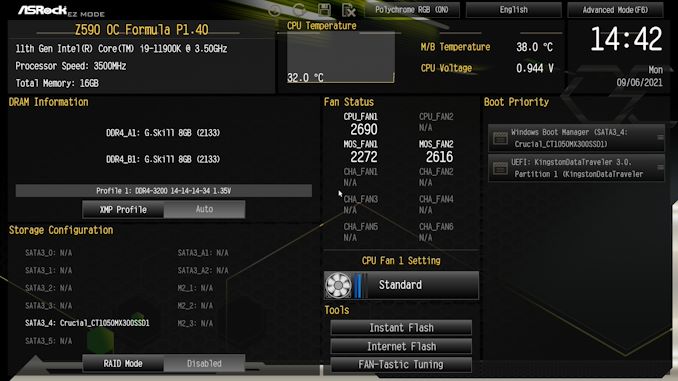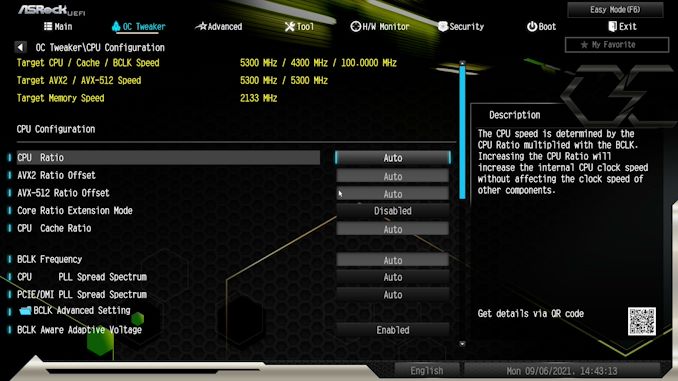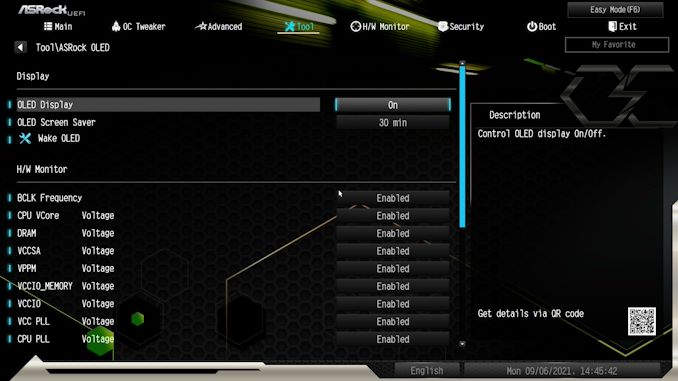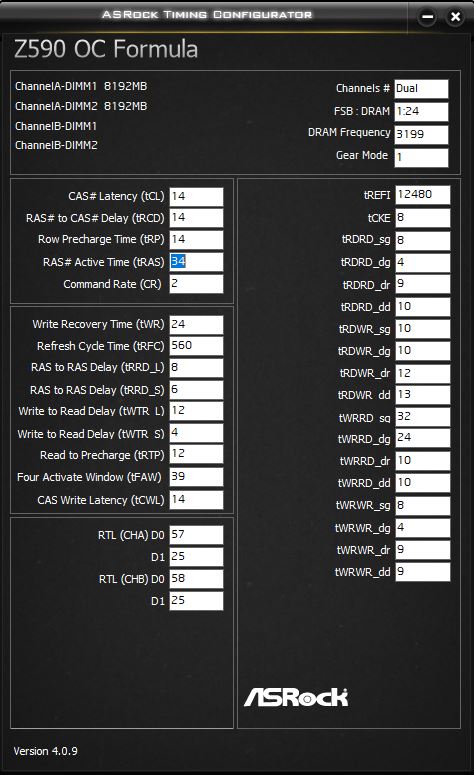The ASRock Z590 OC Formula Review: An Iconic Brand Revival
by Gavin Bonshor on September 10, 2021 9:00 AM ESTBIOS
The UEFI firmware used on all of the three ASRock Z590 boards we have reviewed so far has been consistent in design other than subtle changes to the GUI, such as color. In fact, the firmware on the Z590 OC Formula is visually identical to that used on the ASRock Z590 Taichi. The Z590 OC Formula GUI consists of a black background, yellow accents, white text, and grey, denoting which option is currently selected. There are also two different modes for users accessing the firmware, the EZ mode for novice users and the Advanced mode for the more experienced.
The EZ mode, which is the initial splash screen when users first enter the BIOS, includes a basic list of information and settings related to the system. The top left-hand corner is a list of information based on the processor installed, with the default CPU core frequency and the total combined memory capacity installed. Below is a list of the memory installed, including a panel for users to click to enable X.M.P 2.0 profiles on compatible memory. In the center panel is a list of installed fans, including fan speed in RPM, with a small panel below this to allow users to select between the different fan profiles such as standard, silent, and full-speed. Users can adjust and select the boot priority from a simple and intuitive list of storage installed on the right-hand side.
Users can access the Advanced section of the firmware by pressing the F6 key. In the Advanced mode, users will find all of the board's overclocking, chipset, and power-related settings. The overclocking settings can be found within the OC Tweaker section, and ASRock has three different submenus for the CPU, DRAM, and voltages. On the main page, users can enable the LN2 preset designed and tested by Nick Shih himself, but regular users should avoid using this as it is designed purely for extreme overclockers. There are plenty of options for overclocking the CPU, including core frequency, cache frequency, BCLK frequency, and AVX offsets which allows for better stability when using a workload using one of the heavier instruction sets.
Users can also make numerous memory tweaks aside from enabling X.M.P 2.0 profiles on compatible memory kits. This includes extensive memory latency options as well as frequency tuning. Users looking to run higher than DDR4-3600 memory will need to switch to Gear 2 of Intel's new geared memory controller. As expected on a motherboard designed for overclockers, there are many voltage options to select from, which is necessary when performing extreme overclocks with sub-zero cooling methods.
A new feature on the ASRock Z590 OC Formula is an OLED panel customizer which is located within the firmware. The OLED panel provides real-time telemetry data from various sensors such as the CPU, temperature, and voltage sensors located within the circuitry. Users can enable or disable certain elements that are displayed and customize the OLED screen saver time or disabled it altogether.
Other useful parts of the firmware include ASRock's FAN-Tastic tuning, where users can customize fan profiles on the eight 4-pin headers. Users can also customize the board's integrated RGB LED lights via the ASRock Polychrome RGB tab, although the software included does offer more elements and lighting settings. Overall, ASRock's OC Formula BIOS is consistent with other ASRock firmware we've seen so far on Z590, and we found it responsive, intuitive. It has plenty of options for overclockers to sink their teeth into.
Software
ASRock provides much of the same core software with the Z590 OC Formula as it does with its other Z590 models, but it includes slightly more intuitive overclocking software. This is expected given the board's overclocking pedigree, although the majority of the software orbits around the ASRock Live Update and App Shop.
The ASRock Live Update and App Shop allows users to not only update all of the board's drivers to the latest versions, but it allows users to install each of the software utilities compatible with the OC Formula. Software available to download includes the Nahamic 3 Utility, which allows customization of audio settings, the Polychrome RGB LED utility for customizing the board's integrated RGB LED lighting, and the Formula Drive software.
Looking closer at ASRock's OC Formula Drive software, it's basically a renamed A-Tuning utility we've seen from previous ASRock motherboards. It provides the functionality for users to overclock the processor within Windows without needing to enter the BIOS. We would like to point out that the CPU VCore control within the Formula Drive utility is based on an offset of the CPU VCore, and not a custom variable, so we recommend users preferring not to calculate the desired CPU VCore to overclock within the firmware. The Formula Drive software also includes a handy system information tab containing many details about frequencies, voltages, and fan telemetry. At the same time, the FAN-Tastic tuning section allows users to customize the aggressiveness of fan curve profiles.
Another handy piece of software designed specifically for extreme overclockers is the ASRock Timing Configurator. This allows users to tweak and change memory latency timings within Windows in real-time.
Overall the software included with the ASRock Z590 OC Formula is everything a user should need, including the ASRock XFast LAN utility for traffic shaping, the Nahimic 3 audio control software, as well as ASRock's Restart to UEFI software which allows users to enter the BIOS upon restarting the system at the click of a button.




























20 Comments
View All Comments
Kracken'm all - Friday, September 10, 2021 - link
Frankly overpriced and useless if we are being scalped hard for higher end cpu and gpu.Actually mobo manufacturers should pay us on top using their board as nvidia and amd are fucking everything up so bad but just don't give a crap but fakers for money.
prophet001 - Friday, September 10, 2021 - link
HPCs are like fishing lures... they're not made to catch fish they're made to catch fishermen.I feel embarrassed thinking about some of the stuff I bought and bought into when I was younger.
Wrs - Friday, September 10, 2021 - link
Why would you blame or take out your anger on a mobo maker for a shortage of cpus/gpus caused by a biological virus?!The mobo is a beast and seems priced at a slight *discount* to the market. Let's hope it's dependable because I don't know about that warranty... probably explains the discount.
For those that don't appreciate on-board power buttons and resets/switches and metal backplates because its all covered by a computer case, get a cheaper board, this one isn't for you. It's a niche product painfully torn between mass-market usability and catering to a small community of hardcore overclockers. Because it includes features for two mutually exclusive audiences, it's always going to be at least somewhat overpriced to either group.
The only complaint I'd have is the placement of that on-board OLED display. It's likely to be obscured by insulation or high end air cooling. Probably should get rid of it, buff up the diagnostic display to a full time monitoring display.
TheinsanegamerN - Monday, September 13, 2021 - link
"Why would you blame or take out your anger on a mobo maker for a shortage of cpus/gpus caused by a biological virus?!"Still on that theory? That's cute. There's plenty of GPUs shipping out of china, they just are not coming to us.
" It's a niche product painfully torn between mass-market usability and catering to a small community of hardcore Suckers."
FTFY. All this money and design for another 50 MHz bin over a normal $180 Z series board. The days of hardcore OCingbeing entertaining ar ebehind us when CPUs hit 95% of that performance level on their own now.
Wrs - Monday, September 13, 2021 - link
What? It's generally accepted that Covid is the primary cause of the chip shortage, but far from the only cause. Covid produced quarantines and lockdowns, messed with factory production here and there, made a lotta people scramble for electronics to work from home - there's the impact on both supply and demand. There are some compounding factors like China tariffs, an island off China running out of water (I don't say that with a straight face), car industry cutting orders before a surprise sales boom, and other details I needn't list here.Overclocking is legit, but getting more niche these days - on that you are absolutely right. The mainstream has trended toward what formerly was entry level OC - big beefy ambient coolers. I don't particularly like the inefficient Rocket Lake to start - inefficiency is what necessitates expensive boards, after all - but this article isn't about a board built for mainstream cooling, and 50 MHz is certainly not all you're expected to get over a $180 board... though perhaps it is close to all you'll get using what this site did, an ambient AIO cooler. That's just not right to cool >300w in half a square inch, nor is it any good for reducing thermal and electrical resistivity in silicon. Rocket Lake runs so hot, the minimum you'd need to see real progress is ice water. This board, with all its slow boot switches, is clearly set up for phase change or LN2, and I am not prepared to ask Anandtech to cough up that kind of expertise...
Spunjji - Monday, September 13, 2021 - link
"Frankly overpriced and useless"Yes
*everything else you wrote*
No
svan1971 - Friday, September 10, 2021 - link
AsRock before you buy check out their warranty info its a disaster.Slash3 - Friday, September 10, 2021 - link
The first board in the series was the Z77 OC Formula, not the Z87. I've still got mine running in a secondary system. :)Slash3 - Friday, September 10, 2021 - link
One other note, the testbed chart lists an 11900K with pricing of $374, which is clearly incorrect.AllMuscle1 - Friday, September 24, 2021 - link
Same here! I was about to laugh when I saw it clearly displayed in the photograph and yet, he stated Z87. The Z77 for Ivy Bridge was amazing! It's now in my daughter's system.